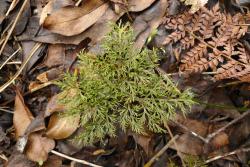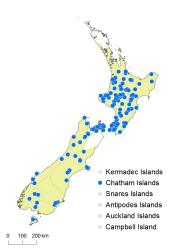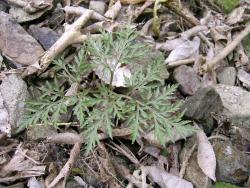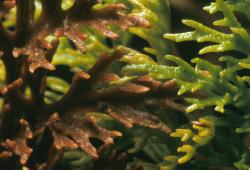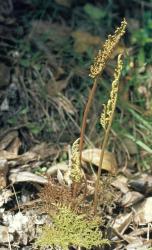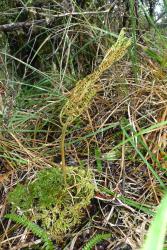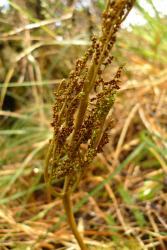- ≡ Sceptridium biforme (Colenso) Lyon, Bot. Gaz. 40: 457 (1905)
- = Botrychium ternatum var. australasiaticum δ millefolium F.Hochst. ex Milde, Verh. K. K. Zool.-Bot. Ges. Wien 19: 158 (1869)
- ≡ Botrychium australe var. millefolium (F.Hochst. ex Milde) Prantl, Jahrb. Königl. Bot. Gart. Berlin 3: 341 (1884)
Rhizomes erect, subterranean, 5–50 mm long, glabrous; roots thick, fleshy, not ridged or contractile, up to 3 mm diameter. Fronds 70–440 mm long, divided into a sterile lamina and fertile sporophore. Stipes 15–65 mm long, pale or chestnut-brown, glabrous or bearing scattered colourless hairs. Sterile laminae borne on a stalk 13–175 mm long, laminae divided 5–7 times, broadly ovate or pentagonal or broader than long, 11–170 mm long, 22–185 mm wide, green or bronze, herbaceous or coriaceous, glabrous or bearing scattered colourless or pale brown hairs. Ultimate segments narrowly ovate to linear, long acuminate, margins entire or with a few deep divisions, 0.2–1.0 mm wide. Sporophore held above the sterile lamina, borne on a stalk 38–300 mm long, divided 3–5 times, narrowly ovate to broadly ovate, 15–105 mm long, 10–60 mm wide, fleshy, glabrous or bearing scattered colourless hairs. Sporangia sessile or subsessile, clustered on branches of the sporophore, 0.6–1.1 mm diameter.
Botrychium biforme is very similar to B. australe in overall shape and size. It is distinguished by its more divided frond, and by the ultimate segments which are narrower (0.2–1 mm wide) and rather more acuminate than those of B. australe which are broader (1.3–5 mm wide) and acute or obtuse. Both species have green and bronze colour forms, and have large fleshy roots containing starch, but B. biforme lacks the ridged and contractile roots of B. australe (Braggins 1980).
North Island: Auckland, Volcanic Plateau, Gisborne, Taranaki, Southern North Island.
South Island: Western Nelson, Sounds-Nelson, Westland, Canterbury, Otago, Southland, Fiordland.
Chatham Islands, Stewart Island.
Altitudinal range: 20–900 m.
Botrychium biforme occurs in lowland and montane areas of the North Island from Hamilton and East Cape south to Cook Strait. There is a 19th century collection in the Cheeseman Herbarium from the Bay of Islands (AK 952), a long way north of its known distribution, which needs confirmation. The species extends from about 20 m in Wellington to 900 m in the central North Island. It is widely distributed, but uncommon, in lowland and montane areas of the South Island, and also reaches Stewart Island and the Chatham Islands. It extends to 750 m in the Eyre Mountains, Southland. Botrychium biforme and B. australe sometimes occur together.
Botrychium biforme occurs in podocarp, beech and broadleaved forest, under mānuka and kānuka and in open areas, on track sides, river flats, stream banks, silty streambeds, lake margins, swampy ground, clay banks, bush margins, in tussock and grassland and on sandy or stony soils. It is more tolerant of shade and has a more southerly distribution than B. australe. Plants occur singly or in large patches, but populations are often widely separated; they die down completely in winter, emerging again in spring from the underground rhizome.
n = 45 (Brownlie 1961).
The name Botrychium dissectum Sprengel, and combinations based on it, have been misapplied to B. biforme.
Braggins recorded plants with sterile lamina stalks up to 200 mm long and blades up to 250 mm long, but such large specimens have not been seen in this study.



